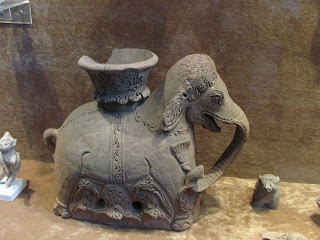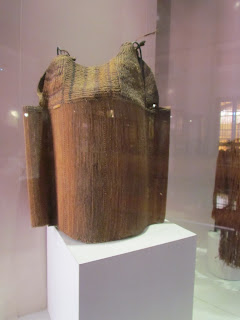 It ain't no Melbourne Museum, that's for sure. Sometime in the late 18th century, J.C.M. Rademacher of Holland, one of the Dutch colonial fat cats in Indonesia decided that he really didn't need his house any longer. Perhaps he had decided to take up residence in his country estate. Maybe he had received his papers allowing him to return home. Maybe it was just time to upgrade. There was a society that was building a museum-like collection, so he gave the house to them. The house was turned into a museum. Over the years the collection grew to where the house was no longer big enough so they built an actual museum-like building as an annex right next door. I presume that the Rademacher items were what were mostly housed in what was formerly his house and much of the newer items to the collection are now housed in the annex. I can only imagine what the locals thought of colonial houses and their owners, but I suspect it really couldn't have been all that favourable.
It ain't no Melbourne Museum, that's for sure. Sometime in the late 18th century, J.C.M. Rademacher of Holland, one of the Dutch colonial fat cats in Indonesia decided that he really didn't need his house any longer. Perhaps he had decided to take up residence in his country estate. Maybe he had received his papers allowing him to return home. Maybe it was just time to upgrade. There was a society that was building a museum-like collection, so he gave the house to them. The house was turned into a museum. Over the years the collection grew to where the house was no longer big enough so they built an actual museum-like building as an annex right next door. I presume that the Rademacher items were what were mostly housed in what was formerly his house and much of the newer items to the collection are now housed in the annex. I can only imagine what the locals thought of colonial houses and their owners, but I suspect it really couldn't have been all that favourable. It's called the Elephant House. The reason is the big elephant statue out front.
It's called the Elephant House. The reason is the big elephant statue out front. The first part of the museum in the house part was all about different pottery techniques and from different regions. It started with terracotta. I was amazed at how detailed terracotta could become, even though I have visited the terracotta warriors site in China and seen the detail there.
The first part of the museum in the house part was all about different pottery techniques and from different regions. It started with terracotta. I was amazed at how detailed terracotta could become, even though I have visited the terracotta warriors site in China and seen the detail there.There was even a terracotta piggy bank. I wonder now where exactly we got the notion for piggy banks. The other day, in the banking museum, there was an assortment of different animal banks.
 Then it was on to the pottery of different cultures and countries. I really didn't spend that much time on them. I've seen them before and learned about them as well. But I have never seen a really good collection of the different dynastic potteries of China. And there is a real difference between the various periods. And the detail in the Ming dynastic pottery is absolutely amazing.
Then it was on to the pottery of different cultures and countries. I really didn't spend that much time on them. I've seen them before and learned about them as well. But I have never seen a really good collection of the different dynastic potteries of China. And there is a real difference between the various periods. And the detail in the Ming dynastic pottery is absolutely amazing.The next gallery was showing the different houses of Indonesia. Ho hum. They're made of wood. Many are on stilts because of flooding and storage. They have a kitchen and eating here, a sleeping area there, a meeting over yonder, yada, yada, yada.
In another gallery there was some prehistoric stuff, axes, spearheads, and the like. Despite that, the other man in the gallery was arranging a fire extinguisher, the door and piece of machinery beside the door very carefully into some sort of artistic array for a photograph. I wish I could have found a way to surreptitiously take a photo of him taking his photo. Oh well.
Then it was on to the culture galleries of the different peoples of the different islands on Indonesia. It was more interesting looking at the clothing and weapons and utensils of the different groups, but after a while they got to looking the same. I suppose that anthropologists and others who study these sorts of things could find all sorts of differences between the items from different groups and spend hours lecturing on them (boring the audience no end), to someone who was casually wandering through the galleries, it all really looked the same. So there were blouses made of some kind of tree.
There were musical instruments, that seemed to be the same sort of thing I saw in Bali during one of the cultural performances.
 There were a couple of interesting things. One was a shrine to the dead. I'm not sure I would want that hanging out in my home.
There were a couple of interesting things. One was a shrine to the dead. I'm not sure I would want that hanging out in my home. Then I finished with the house and passed through the link to the museum building part of the museum.
Then I finished with the house and passed through the link to the museum building part of the museum. I guess there is some 100% Indonesian online game that was being either introduced or launched on the day I visited. Okay, I guess museums are becoming more progressive and trying to appeal to younger generations.
I guess there is some 100% Indonesian online game that was being either introduced or launched on the day I visited. Okay, I guess museums are becoming more progressive and trying to appeal to younger generations. From there it was on into the galleries of the museum building. These were a bit more interesting to begin with. There were dioramas depicting early Indonesian people.
From there it was on into the galleries of the museum building. These were a bit more interesting to begin with. There were dioramas depicting early Indonesian people. There were what I presumed to have been replicas of some of the early graves that were found by anthropologists and archaeologists...
There were what I presumed to have been replicas of some of the early graves that were found by anthropologists and archaeologists... And then it was up the inactive escalators to the galleries of the museum building. These were reminiscent of normal style museums with rows and rows of glass cases and pedestals of artefacts found by archaeologists. The Borobudur case held my interest for a moment.
And then it was up the inactive escalators to the galleries of the museum building. These were reminiscent of normal style museums with rows and rows of glass cases and pedestals of artefacts found by archaeologists. The Borobudur case held my interest for a moment. But mostly it was just the same old sort of thing one expects to find in a museum. And it really wasn't terribly interesting. The curators also didn't seem to have been terribly interested either. There were often descriptions of stuff that really bore no relation to the items around the descriptions. Here for instance is a description of fishing gear and techniques. However, the stuff around it was furniture and house stuff. They have some work to do.
But mostly it was just the same old sort of thing one expects to find in a museum. And it really wasn't terribly interesting. The curators also didn't seem to have been terribly interested either. There were often descriptions of stuff that really bore no relation to the items around the descriptions. Here for instance is a description of fishing gear and techniques. However, the stuff around it was furniture and house stuff. They have some work to do.The top gallery was all about treasure that has been gathered. There were cases filled with gold, silver, and gemstones. And no photographs were allowed. But again, just your traditional sort of museum setting. On the other hand, the only way in was by elevator. To get to the second and third floors you used escalators or the elevator, but the fourth floor was only accessible by elevator. I suppose that was to make it harder for would-be thieves.
Finally, somewhat disappointed in the museum (that only cost a dollar, so what did I expect?), I wandered down into a temporary exhibit on the first floor. That was an interesting exhibit. It was about future solutions to living. I wasn't sure how they all applied to that problem, but there was a prefab bamboo house that can be put up in areas hit by disaster, such as last year's volcanic eruption of a mountain here in Indonesia. Prefab bamboo house? The lighting in the exhibition was too low for good photos, unfortunately. It looked like what you would expect for a bamboo house, though. There was a giant tube of very light aluminum foil. It looked like a slug. I'm not sure what it was for because I couldn't find the description for it. There was a collapsible arch of fiber-optic cables. It was about 10 feet long and could collapse down to fit in a backpack. Again, I'm not really sure of it's application.
And there was a project by some Indonesian architects. The major river that passes through Jakarta is called the Ciliwung. As Jakarta has become the city of dreams for many Indonesians, people have flocked here, putting more and more pressure on the area, and its river. People have lived beside it, bathed in it, done laundry in it, used it as a toilet and a garbage dump. In short, they have ill-treated it for so long that it is dirty, polluted and unusable. And as it has become penned by artificial banks, sickened and withered by pollution, and anything living in or beside it has suffered as well, it is a symbol of the environmental degradation wrought in this area. The architects' presentation talked of solutions for the problem. They looked at relocating the people who live beside the river and then reclaiming and rehabilitating the banks. They rejected as not very workable in practice. Their vision was to put up these structures over and under and in the river that would clean the water, provide parks and other usable spaces for use by residents, and even living spaces. I'm not sure that it is any more workable, but it is a nice vision. And I am virtually certain that it will never come to be. There is too much corruption in Indonesian government to get the money for it to be done, and the resources to build it probably couldn't be assembled. I wish them luck.





















Positive site, where did u develop the information with this posting? I'm pleased I came across it though, ill be checking back soon to discover what additional posts you include.jasa interior kantor jakarta
ReplyDelete